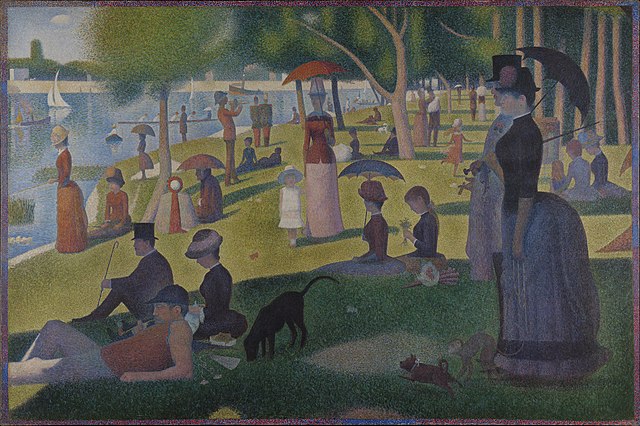Le Chahut is a Neo-Impressionist painting by Georges Seurat, dated 1889–90. It was first exhibited at the 1890 Salon de la Société des Artistes Indépendants in Paris. Chahut became a target of art critics, and was widely discussed among Symbolist critics.
Le Chahut
Edgar Degas,1876-77, Café Concert at Les Ambassadeurs, Musée des beaux-arts de Lyon
Georges Seurat, 1889-90, Jeune femme se poudrant (Young Woman Powdering Herself), oil on canvas, 95.5 x 79.5 cm, Courtauld Institute of Art
Georges Seurat, 1891, Le Cirque (The Circus), oil on canvas, 185 x 152 cm, Musée d'Orsay, Paris
Neo-Impressionism is a term coined by French art critic Félix Fénéon in 1886 to describe an art movement founded by Georges Seurat. Seurat's most renowned masterpiece, A Sunday Afternoon on the Island of La Grande Jatte, marked the beginning of this movement when it first made its appearance at an exhibition of the Société des Artistes Indépendants in Paris. Around this time, the peak of France's modern era emerged and many painters were in search of new methods. Followers of Neo-Impressionism, in particular, were drawn to modern urban scenes as well as landscapes and seashores. Science-based interpretation of lines and colors influenced Neo-Impressionists' characterization of their own contemporary art. The Pointillist and Divisionist techniques are often mentioned in this context, because they were the dominant techniques in the beginning of the Neo-Impressionist movement.
Neo-Impressionism
Paul Signac, 1890, Portrait of Félix Fénéon (in front of an enamel of a rhythmic background of measures and angles, shades and colors), oil on canvas, 73.7 × 92.5 cm (28.9 × 36.4 in.), Museum of Modern Art, New York
Henri-Edmond Cross, The Evening Air (l'Air du soir), c. 1893, oil on canvas, 116 × 164 cm, Musée d'Orsay, Paris
Georges Seurat, Le Cirque, 1891, oil on canvas, 185 x 152 cm, Musée d'Orsay, Paris








